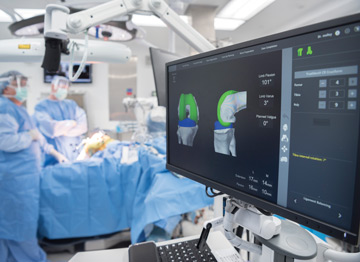Knee replacement specialists can measure twice and cut once with saws and drills and feel pretty confident that the implants they place will align perfectly with the femur and tibia to restore near-natural joint function. Or they can rely on robotic guidance and be 100% certain.
“No surgeon needs a robot, but they could certainly benefit from using one,” says Michael Suk, MD, JD, MPH, MBA, FACS, chair of the Geisinger Musculoskeletal Institute in Scranton, Pa. “The purpose of the robot isn’t to perform easy cases. It’s to make difficult cases easier.”
Use of robotics is trending upward as more surgeons buy into the technology, new platforms come to market and savvy patients seek out facilities that have invested in it. You could argue that robotic assistance is the inevitable future of knee replacement surgery thanks to the many clinical benefits it provides.
Orthopedic surgeon Kim Schaap, MD, is a convert. She performed her first robotic knee replacement at the St. Cloud (Minn.) Surgical Center in October 2016 and quickly realized how much she liked working with the technology. “It’s helpful during every single case,” says Dr. Schaap. “There are joints in which you know it’s going to be a struggle to insert the implant based on the patient’s anatomy. The robot eliminates those outliers.”
The experts we spoke to say robotic assistance brings a higher degree of precision to preparing for surgery, placing implants and balancing ligaments.
“Does robotics improve outcomes, or does it simply make post-op X-rays look better?”
— Yale Fillingham, MD
- Pre-op planning. Dr. Suk calls robotics a complete joint replacement platform. Combining advanced CT imaging with robotics lets surgeons develop a detailed surgical plan based on a patient’s specific knee anatomy — a place that the robot will help execute it in the OR.
“Pre-op planning takes away some of the intraoperative high-stakes decision-making,” says Dr. Suk. “I find myself in a much better situation in terms of having really thought about the case to a level beyond what size implant to use. There are no surprises during surgery.”
Dr. Schaap says entering the OR with a digital map of surgery and an idea of how the procedure will progress results in less bone resection, which is especially important when using newer implant systems. “The robot lets us make very small bone cuts and correct significant deformities because we understand the three-dimensional anatomy of the joint,” says Dr. Schaap.
- Implant alignment. Yale Fillingham, MD, a joint replacement specialist at Dartmouth-Hitchcock Medical Center in Lebanon, N.H., says implants placed outside of a certain range of alignment have increased risk of failing, because of the constant change in stress that works across the bone-cement interface whenever the patient moves. Being even just a few millimeters off in alignment can make a difference in implant lifespan.
Surgeons can use a robot’s software platform to identify anatomic reference points and anomalies, and preview the overall morphology or the shape of the joint’s bony anatomy. They then preoperatively plan to place the tibial and femoral cuts exactly where they want them. “One theory in support of robotics is that the technology increases implant survivorship by letting surgeons place implants in the correct alignment,” says Dr. Fillingham.
Dr. Schaap says robotic assistance helps her establish proper rotational alignment of the tibia and femur, especially in badly deformed valgus externally rotated knees. Patellofemoral alignment is also improved, which strengthens the joint for going up and down stairs and getting in and out of chairs. Ultimately, she says, precise implant placement leads to improved joint mechanics, which allow for better power and better feel in the joint, important factors that impact patient satisfaction.
“If advanced imaging and pre-op planning lets you be more precise with putting in implants every single time, outcomes should be influenced in a positive way,” says Dr. Suk. “That’s a logical step.”
- Ligament balancing. The ligaments in a replaced knee need to provide equivalent balance with the knee at full extension and at 90 degrees of flection. “The problem,” points out Dr. Fillingham, “is that no one knows what the perfect balance is.”
Dissatisfied knee replacement patients often complain that their joints feel “too loose” or “too tight,” says Dr. Fillingham, adding that most surgeons err on the side of making knees tight to prevent the joint from feeling unstable. He believes robotics will improve outcomes by quantifying the perfect ligament balance.
“Instead of telling surgeons what ligament balancing should be, the technology currently tells surgeons what it is,” says Dr. Fillingham.
“Over time, that information will serve as a data point. When the technology is more widely adopted, we’ll have the potential to determine the ideal ligament balance based on specific patient factors. Robotic assistance already helps us achieve more consistent outcomes, and could eventually identify exactly how surgeons should balance knees.”
.svg?sfvrsn=be606e78_3)

.svg?sfvrsn=56b2f850_5)